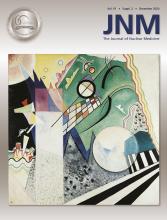In the 1980s, 201Tl scintigraphy helped to introduce noninvasive assessment of myocardial perfusion as an important clinical tool for the detection and management of coronary artery disease (CAD). Monovalent cations such as 201Tl exhibit pharmacokinetics that are very suitable for the assessment of regional myocardial perfusion. Early uptake based on a high first-pass extraction fraction of the radioisotope correlates linearly with myocardial blood flow over a wide flow range, allowing the sensitive detection of impaired coronary flow reserve. At later time points, the tracer washes out differentially, producing a redistribution pattern that has experimentally and clinically been linked to myocardial tissue viability. Therefore, the use of one tracer such as 201Tl has successfully addressed several clinical questions in patients with acute and chronic CAD and has established nuclear cardiology as a subspecialty of both nuclear medicine and cardiology (1). However, 201Tl has drawbacks due to its low photon energy. Image quality is less than optimal, which was especially appreciated as nuclear cardiology moved to SPECT. In addition, the long physical half-life of 201Tl is associated with a relatively high radiation exposure, which was further aggravated by the technique of reinjection as a means to enhance the redistribution process for the detection of regional tissue viability (2). For this reason, the advent of 99mTc-labeled blood flow tracers was very much welcomed by the nuclear cardiology community. Initial animal studies, however, showed that the physiologic characteristics in terms of first-pass extraction fraction were less optimal than those of 201Tl (3). But the higher photon energy and the ease of preparation by commercially available 99mTc generators and kits overcame these limitations. First clinical experience showed that the diagnostic accuracy to detect regional CAD was quite comparable to that of 201Tl imaging (4). Since 99mTc-sestamibi does not redistribute, imaging can be performed for a long period after tracer injection, still reflecting blood flow distribution at the time of injection. This slow redistribution has been exploited for assessment of patients with acute myocardial infarction, leading to measurement of infarct size as well as myocardial salvage after intervention during acute myocardial infarction, and served as an endpoint in clinical trials (5). A major support of technetium-labeled flow tracers came with the introduction of gated SPECT imaging, which provided excellent information on global and regional left ventricular function. Thus, the combination of perfusion imaging and functional parameters such as ejection fraction enhanced the diagnostic and prognostic value of myocardial perfusion imaging.
The rapid propagation of 99mTc-labeled flow tracers was very much supported by close cooperation between academia and industry to standardize imaging protocols and analysis software. Especially, the groups of Drs. Daniel Berman, Ernest Garcia, and James Corbett developed software packages that allowed objective and quantitative methods to compare stress and rest perfusion images. Since most camera manufacturers provided integrated software packages associated with standardized study protocols, a unified approach for myocardial perfusion imaging emerged within the nuclear cardiology community. In addition, the Association of Nuclear Cardiology offered a means to certify not only nuclear medicine physicians but also cardiologists by providing an interdisciplinary certification process, which further contributed to the clinical success of myocardial perfusion imaging.
Altogether, the introduction of a new technetium-labeled blood flow tracer with superior imaging qualities and less radiation exposure, as well as the introduction of gated SPECT, highly supported the success of 99mTc-labeled flow tracers as standard procedure in the management of CAD. Large databases built on standardized data acquisition documented the prognostic role of semiquantitatively measured parameters for the management of CAD patients. The success of nuclear cardiology, with more than 10 million examinations per year in the United States, is based on the coordinated and interdisciplinary approach to this new class of radiopharmaceuticals. The paper of Frans Wackers et al. in 1989 (6) in this anniversary issue of JNM was an important building block to the success story of nuclear cardiology over the last 30 years.
DISCLOSURE
The research of the author has received funding from the Deutsche Forschungsgemeinschaft (DFG) under grant agreement SFB 824. No other potential conflict of interest relevant to this article was reported.
- © 2020 by the Society of Nuclear Medicine and Molecular Imaging.
REFERENCES
- Received for publication June 11, 2020.
- Accepted for publication June 15, 2020.







